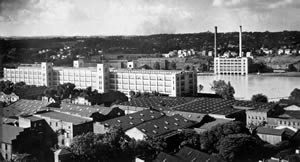The Southern Mill Industry
 Until the 1850s, the Piedmont region was considered the South’s
“back country,” populated mainly by white yeoman farmers and
tenants of large land holders. Households relied for most of the necessities
on home production or barter with a tight network of kin and neighbors.
With their subsistence lifestyle, farming communities in the region had
little need for cultural interaction and commercial ties with the wider
world.
Until the 1850s, the Piedmont region was considered the South’s
“back country,” populated mainly by white yeoman farmers and
tenants of large land holders. Households relied for most of the necessities
on home production or barter with a tight network of kin and neighbors.
With their subsistence lifestyle, farming communities in the region had
little need for cultural interaction and commercial ties with the wider
world.
Changes began in the 1850s. As the railroad expanded in the South, production of cotton, wheat, and tobacco increased. Entrepreneurs needed capital and a steady supply of workers for the southern mill industry to grow. Aware of the profit potential, merchants, and planters turned their efforts to developing local economies. At first, Piedmont farmers responded to these industrialization attempts with indifference or hostility (Hall 1987). In its initial stages, the Southern mill industry progressed slowly, with only 324,000 active spindles in the South in 1860 and not much more in 1870 (Smith 1960:4).
The true turning point came after the Civil War. With the abolition of slavery, the South reorganized its economy and system of agriculture. Small farmers now worked on credit through the crop lien system, enhancing power of the merchant class. Soon farmers found it impossible to meet the credit demands of postwar merchants by relying on their traditional farming practices and diverse crops. Piedmont farmers turned to producing cash crops in an effort to get out of debt. Yet, as the farmers started concentrating their efforts on products like tobacco and cotton, the agricultural self-sufficiency of the region gradually eroded, trapping yeomen farmers in a cycle of debt.
The richer merchant class started backing mill construction, and greater railroad expansion after the Civil War made intensive construction possible. Merchants responded to the new southern ethos that equated progress with industrialization, and mill construction accelerated in the 1880s (Hall 1987). By 1890, the number of active spindles in southern mills had nearly tripled from 1860 (Smith 1960:4). Northern industrialists encouraged the growth of these new mills because the potential profit from selling textile machinery was great enough to warrant promoting southern textile competitors (Smith 1960:5). Since New England already had a firmly established textile industry, southern businessmen benefitted from the most up-to-date technologies and equipment from the start of their endeavors without wasting investments on outdated methods. These technological advancements also meant that workers unschooled in the craft tradition could be recruited to perform jobs such as making cloth.
Although “roaring mill cities” did not appear overnight, the Piedmont region gradually became the center of the southern industrial transformation. Cities with sources of cheap water power in Virginia, North Carolina, and South Carolina were targeted for the new mills, and soon Danville (situated on the Dan River) became an important mill center. Entrepreneurs actively recruited white farmers to supply labor for these mills (Hall 1987); since tobacco employers mainly relied on African-American workers, cotton mill promoters promised the mill would provide work for white laborers (Smith 1960:9).
Several factors induced large numbers of people to migrate to the mills. First among them was the increasing difficulty of earning a living from the land. Many farmers were willing to leave behind the crop lien system and its cycle of debt in the hope of economic advancement in the mills. Others saw the move as a way to keep family and friends together, either joining loved ones who had already made the transition or moving because it was financially impossible to keep the family together otherwise. Some thought the move would be temporary and intended to return to the countryside once they saved some money. Many young women went because they saw farm life as a dead-end while the mills seemed to hold more opportunities. In general, by the late 1800s many Piedmont farmers looked to brighter prospects in the mills, and numerous people throughout the region made the transition. Yet they brought with them their traditions which would show themselves in the culture and kinship ties of the mill towns (Hall 1987).
 Skip to main content
Skip to main content
